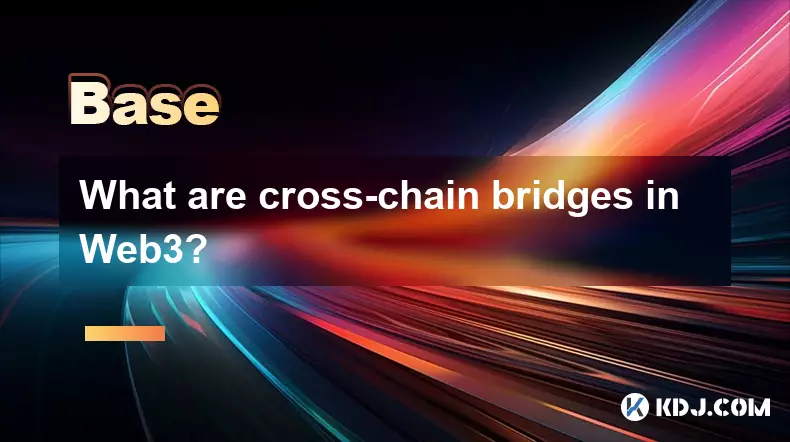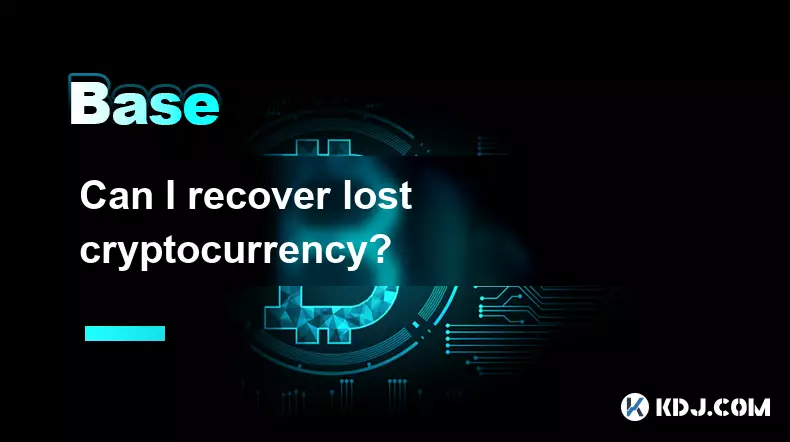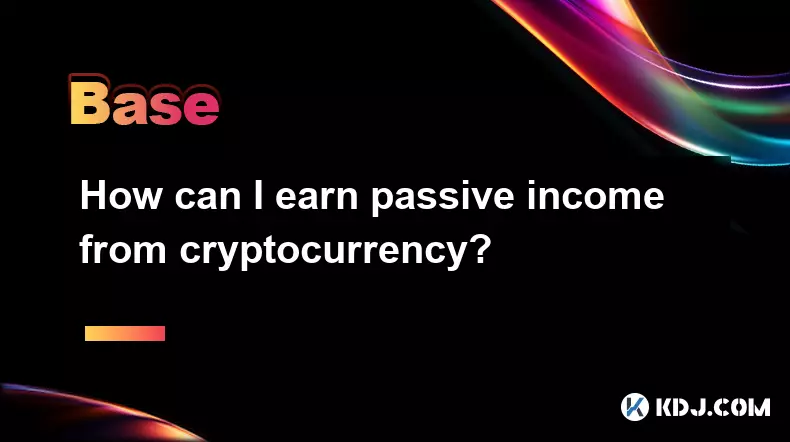-
 bitcoin
bitcoin $109523.663807 USD
-0.13% -
 ethereum
ethereum $4019.526508 USD
2.06% -
 tether
tether $1.000482 USD
0.00% -
 xrp
xrp $2.776815 USD
0.18% -
 bnb
bnb $958.942396 USD
0.12% -
 solana
solana $204.294698 USD
3.84% -
 usd-coin
usd-coin $0.999693 USD
0.00% -
 dogecoin
dogecoin $0.232115 USD
2.09% -
 tron
tron $0.338028 USD
0.84% -
 cardano
cardano $0.790920 USD
1.50% -
 hyperliquid
hyperliquid $44.871443 USD
5.60% -
 ethena-usde
ethena-usde $1.000322 USD
0.04% -
 chainlink
chainlink $21.034165 USD
2.60% -
 avalanche
avalanche $28.794831 USD
-0.54% -
 stellar
stellar $0.360466 USD
1.24%
What are cross-chain bridges in Web3?
Cross-chain bridges enable secure asset and data transfer between blockchains, enhancing interoperability, liquidity, and DeFi growth across diverse networks.
Sep 26, 2025 at 06:54 am

Cross-Chain Bridges: Connecting Blockchain Ecosystems
1. Cross-chain bridges are protocols that enable the transfer of assets and data between different blockchain networks. In a decentralized environment where blockchains operate in isolation, these bridges serve as critical infrastructure for interoperability. They allow users to move tokens from one chain to another, such as transferring Ethereum-based ERC-20 tokens to the Polygon network or Solana.
2. These bridges function by locking assets on the source chain and minting equivalent representations on the destination chain. For instance, when moving ETH to an L2 network like Arbitrum, the original ETH is secured in a smart contract while a bridged version, often labeled as WETH or arbiETH, is issued on Arbitrum. This mechanism preserves the total supply while enabling usability across platforms.
3. Some bridges rely on centralized custodians, while others use decentralized validator networks or cryptographic proofs to ensure security. Trust-minimized designs are preferred in the Web3 community because they reduce reliance on single points of failure and align better with decentralization principles.
4. The demand for cross-chain bridges has surged as users seek lower transaction fees, faster confirmation times, and access to unique dApps on alternative chains. As the multi-chain ecosystem expands, bridges have become essential tools for capital efficiency and liquidity distribution across networks.
Security Challenges and Risks in Bridge Design
1. Despite their utility, cross-chain bridges are frequent targets for hackers due to the large volumes of locked assets. High-profile exploits, such as the $600 million Poly Network breach and the $190 million Nomad hack, highlight vulnerabilities in bridge logic and governance mechanisms.
2. Many attacks exploit flaws in signature verification, message relaying, or validator consensus models. A compromised oracle or improperly validated proof can allow malicious actors to forge transactions and drain funds from the bridge’s reserves.
3. The lack of standardized security frameworks across bridge implementations increases systemic risk within the broader crypto economy. Projects often prioritize speed-to-market over rigorous auditing, leaving gaps that attackers can exploit.
4. Users must assess whether a bridge uses optimistic validation, zero-knowledge proofs, or federated signers before depositing funds. Understanding the trust assumptions behind each design is crucial for minimizing exposure to potential losses.
Types of Cross-Chain Bridge Architectures
1. Lock-and-mint bridges operate by immobilizing tokens on the origin chain and creating wrapped versions on the target chain. Examples include Binance Bridge and Arbitrum Gateway, which facilitate official token migrations under controlled conditions.
2. Liquidity pool-based bridges like Connext or Hop Protocol do not mint new tokens. Instead, they route transfers through pre-funded pools on both sides of the bridge, using atomic swaps or commitment schemes to settle balances across chains.
3. Chain-agnostic messaging protocols such as LayerZero enable generalized data transmission between blockchains. These systems support not only asset transfers but also smart contract calls, allowing dApps to interact seamlessly across ecosystems.
4. Federated bridges rely on a group of trusted validators to confirm cross-chain events, whereas trustless bridges use game theory or cryptography to enforce correctness without intermediaries. The trade-off between speed, cost, and decentralization varies significantly across these models.
Impact on Decentralized Finance and Asset Mobility
1. Cross-chain bridges have enabled DeFi platforms to expand beyond native blockchains. Protocols like Aave and Curve now deploy on multiple networks, leveraging bridges to aggregate liquidity and offer consistent user experiences.
2. Yield farmers and traders utilize bridges to chase higher returns on emerging chains, rapidly shifting capital in response to incentives. This dynamic behavior contributes to the fragmentation and re-allocation of liquidity across the Web3 landscape.
3. Wrapped assets, facilitated by bridges, represent a significant portion of trading volume on many decentralized exchanges. For example, WBTC remains a dominant collateral type in lending markets despite being pegged to Bitcoin and originating off-chain.
4. As more projects adopt omnichain strategies, the ability to maintain synchronized state across blockchains becomes a competitive advantage. Bridges are no longer just transfer tools—they are foundational components of scalable, interconnected applications.
Frequently Asked Questions
What happens if a bridge gets hacked?In the event of a hack, funds locked in the bridge’s smart contracts may be drained or misappropriated. Recovery depends on the project’s emergency response, insurance mechanisms, or community-backed compensation plans. Some teams have managed partial reimbursements through treasury allocations.
Are all wrapped tokens created through bridges?Yes, wrapped tokens such as wETH or WBTC are typically issued via bridge protocols. These tokens represent claims on underlying assets held in reserve and are used to maintain compatibility across chains that don’t natively support certain cryptocurrencies.
How do I choose a secure cross-chain bridge?Evaluate the bridge’s audit history, open-source code availability, team transparency, and past incident responses. Prefer protocols with decentralized validation, active monitoring, and formal verification where possible. Community reputation and integration with reputable wallets also serve as useful indicators.
Can cross-chain bridges be shut down?Centralized bridges can be paused or terminated by operators, especially during technical issues or legal pressure. Decentralized alternatives aim to resist shutdowns through distributed control, though governance decisions or software upgrades may still influence operations.
Disclaimer:info@kdj.com
The information provided is not trading advice. kdj.com does not assume any responsibility for any investments made based on the information provided in this article. Cryptocurrencies are highly volatile and it is highly recommended that you invest with caution after thorough research!
If you believe that the content used on this website infringes your copyright, please contact us immediately (info@kdj.com) and we will delete it promptly.
- BlockchainFX: The Crypto Presale Primed for a 2025 ROI Explosion
- 2025-09-27 18:25:19
- ETH Price Check: Smart Money Stays Cool Amidst ATH Rollercoaster
- 2025-09-27 18:25:19
- Aster Price, MrBeast, and DEX Volumes: What's the Buzz?
- 2025-09-27 18:45:11
- Shiba Inu, Meme Coins, and MAGACOIN FINANCE: What's Next?
- 2025-09-27 18:45:11
- Aster DEX: Navigating DeFi's Future with Price Predictions and Key Insights
- 2025-09-27 18:50:01
- Virtuals Protocol's New Genesis: A Deep Dive into the Launch and $VIRTUAL's Potential
- 2025-09-27 18:50:01
Related knowledge

What are some common methods of cryptocurrency market manipulation?
Sep 27,2025 at 02:55am
Wash Trading and Its Impact on Market Perception1. Wash trading involves an individual or entity simultaneously buying and selling the same cryptocurr...

How do I read a cryptocurrency whitepaper?
Sep 27,2025 at 05:54am
Understanding the Structure of a Cryptocurrency Whitepaper1. Begin by identifying the executive summary, which outlines the project’s core vision and ...

Can I recover lost cryptocurrency?
Sep 25,2025 at 08:18am
Understanding the Nature of Cryptocurrency Loss1. Cryptocurrency operates on decentralized networks, meaning there is no central authority to reverse ...

How do I choose a cryptocurrency investment strategy?
Sep 27,2025 at 03:55pm
Understanding Risk Tolerance in Crypto Investing1. Assessing personal risk tolerance is a foundational step when entering the cryptocurrency market. V...

How can I earn passive income from cryptocurrency?
Sep 23,2025 at 10:18am
Staking Cryptocurrencies for Regular Returns1. Many blockchain networks operate on a proof-of-stake (PoS) consensus mechanism, allowing users to earn ...

What are gas fees in cryptocurrency transactions?
Sep 26,2025 at 02:00am
Understanding Gas Fees in Blockchain Transactions1. Gas fees are payments made by users to compensate for the computing energy required to process and...

What are some common methods of cryptocurrency market manipulation?
Sep 27,2025 at 02:55am
Wash Trading and Its Impact on Market Perception1. Wash trading involves an individual or entity simultaneously buying and selling the same cryptocurr...

How do I read a cryptocurrency whitepaper?
Sep 27,2025 at 05:54am
Understanding the Structure of a Cryptocurrency Whitepaper1. Begin by identifying the executive summary, which outlines the project’s core vision and ...

Can I recover lost cryptocurrency?
Sep 25,2025 at 08:18am
Understanding the Nature of Cryptocurrency Loss1. Cryptocurrency operates on decentralized networks, meaning there is no central authority to reverse ...

How do I choose a cryptocurrency investment strategy?
Sep 27,2025 at 03:55pm
Understanding Risk Tolerance in Crypto Investing1. Assessing personal risk tolerance is a foundational step when entering the cryptocurrency market. V...

How can I earn passive income from cryptocurrency?
Sep 23,2025 at 10:18am
Staking Cryptocurrencies for Regular Returns1. Many blockchain networks operate on a proof-of-stake (PoS) consensus mechanism, allowing users to earn ...

What are gas fees in cryptocurrency transactions?
Sep 26,2025 at 02:00am
Understanding Gas Fees in Blockchain Transactions1. Gas fees are payments made by users to compensate for the computing energy required to process and...
See all articles









































































